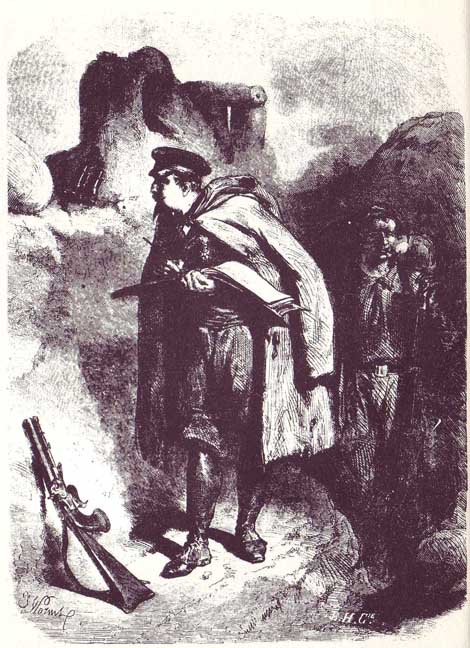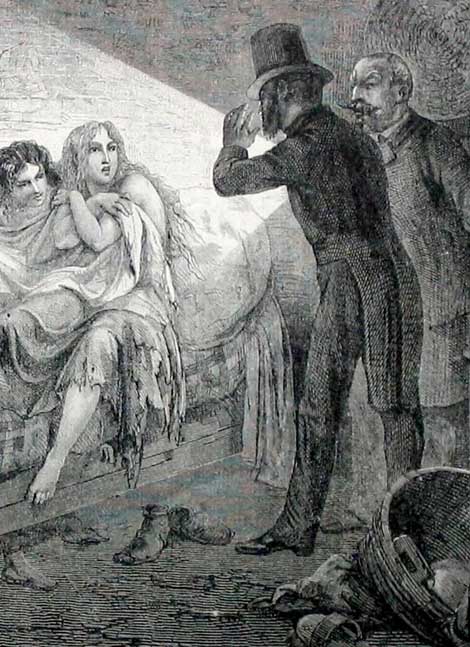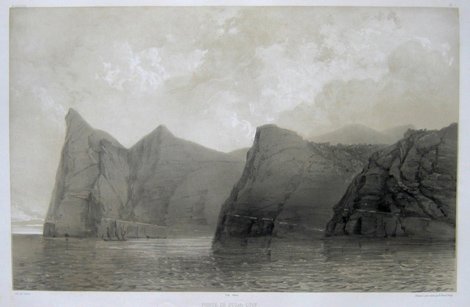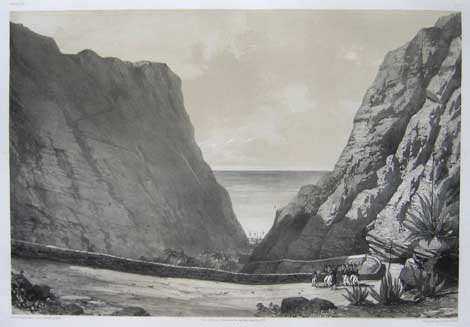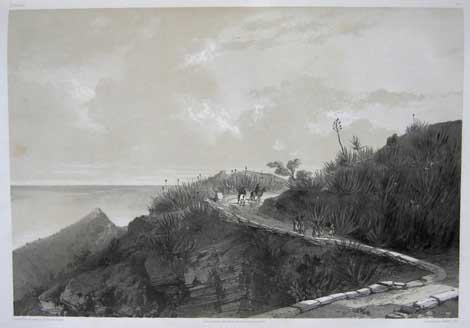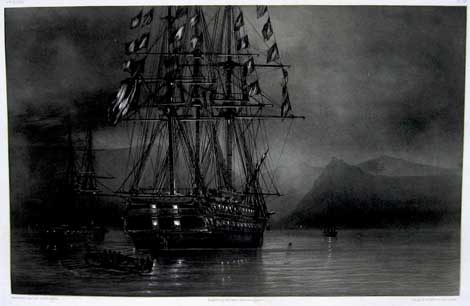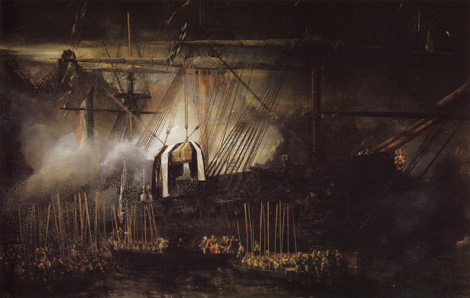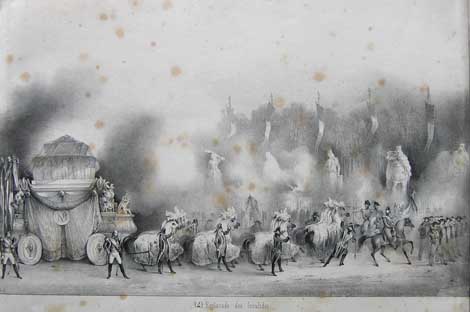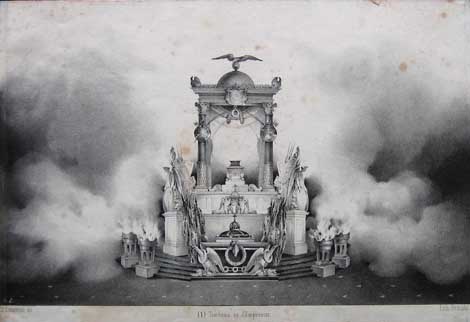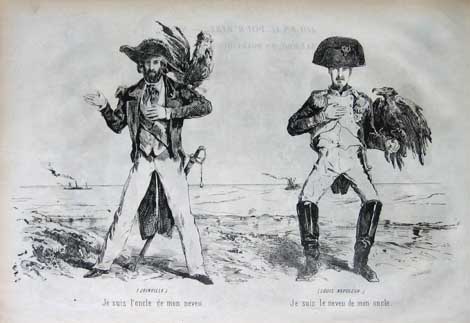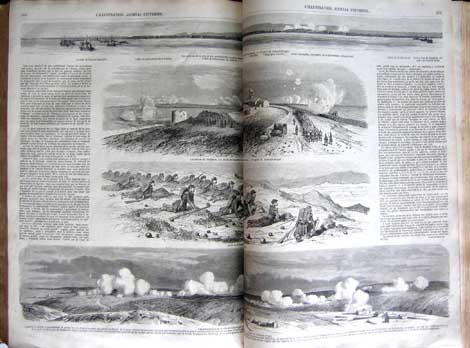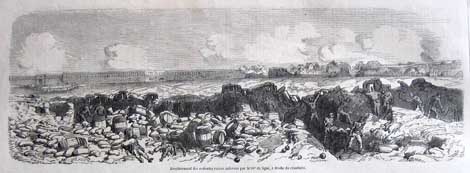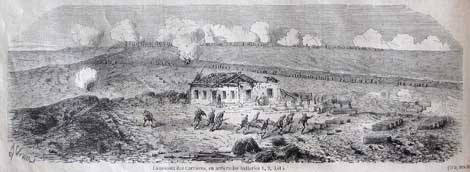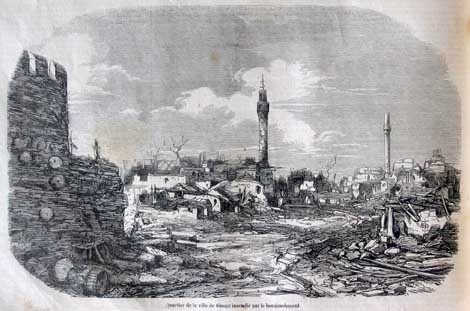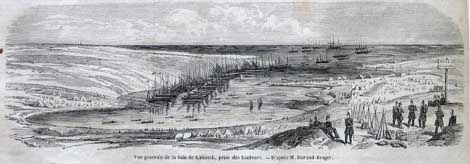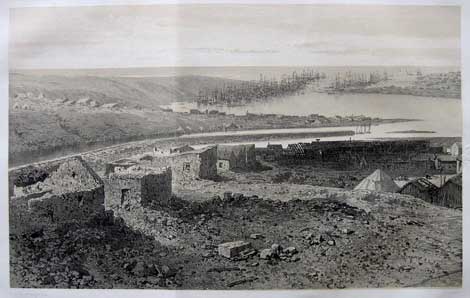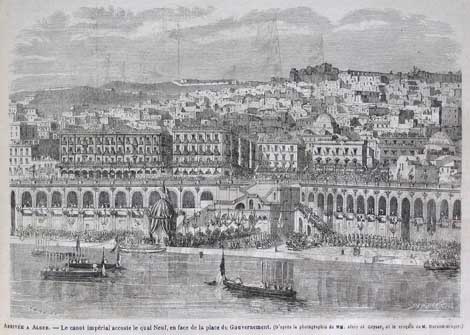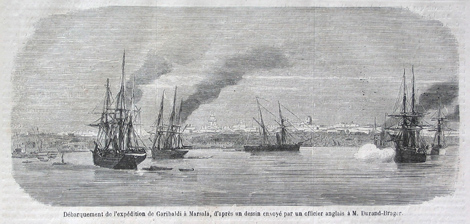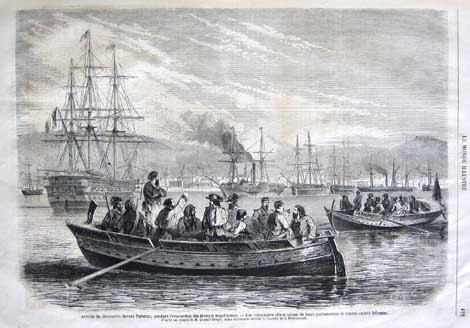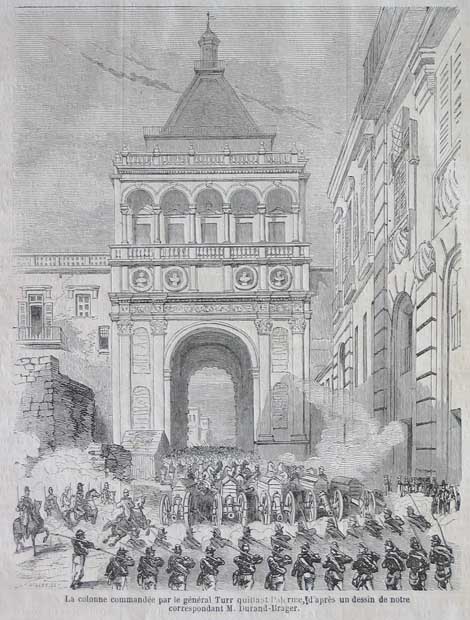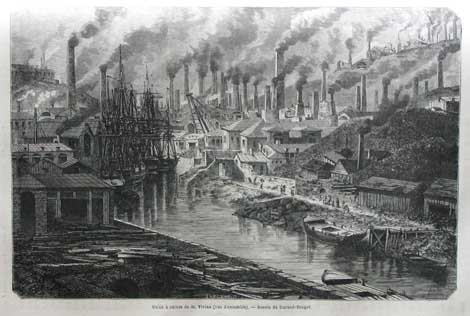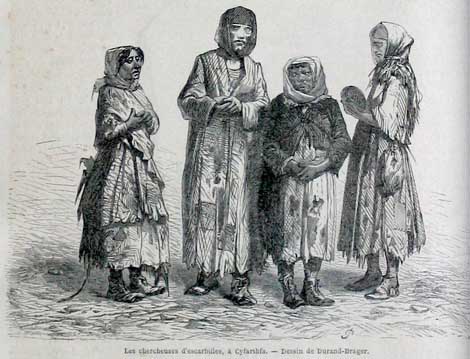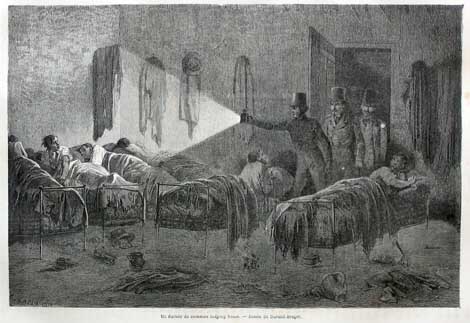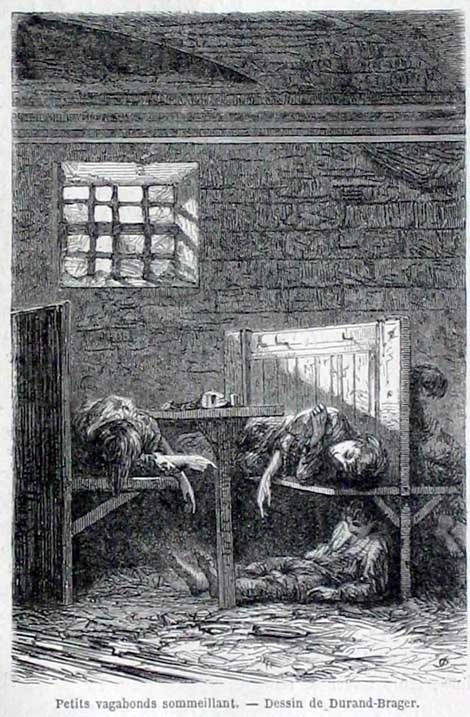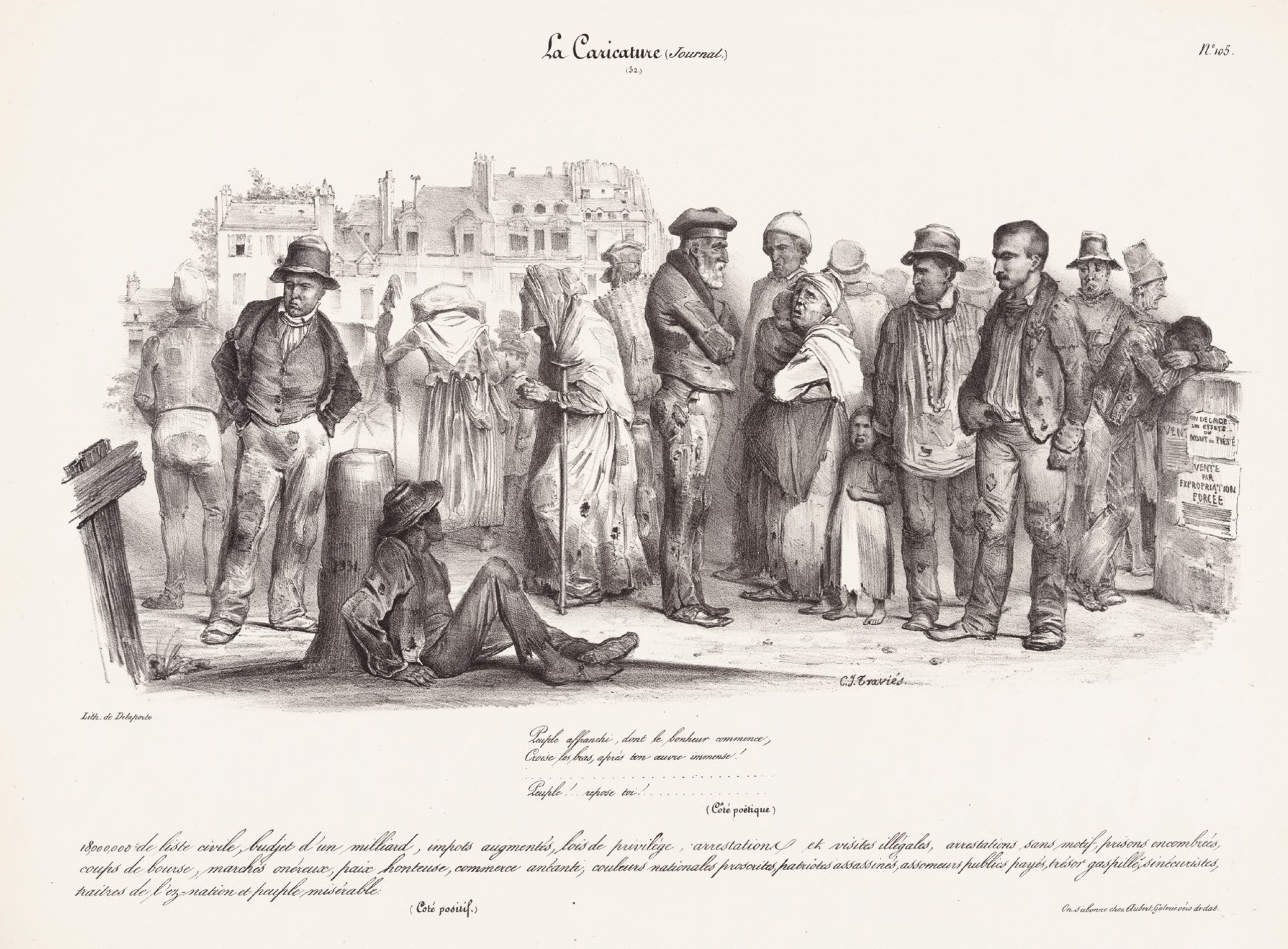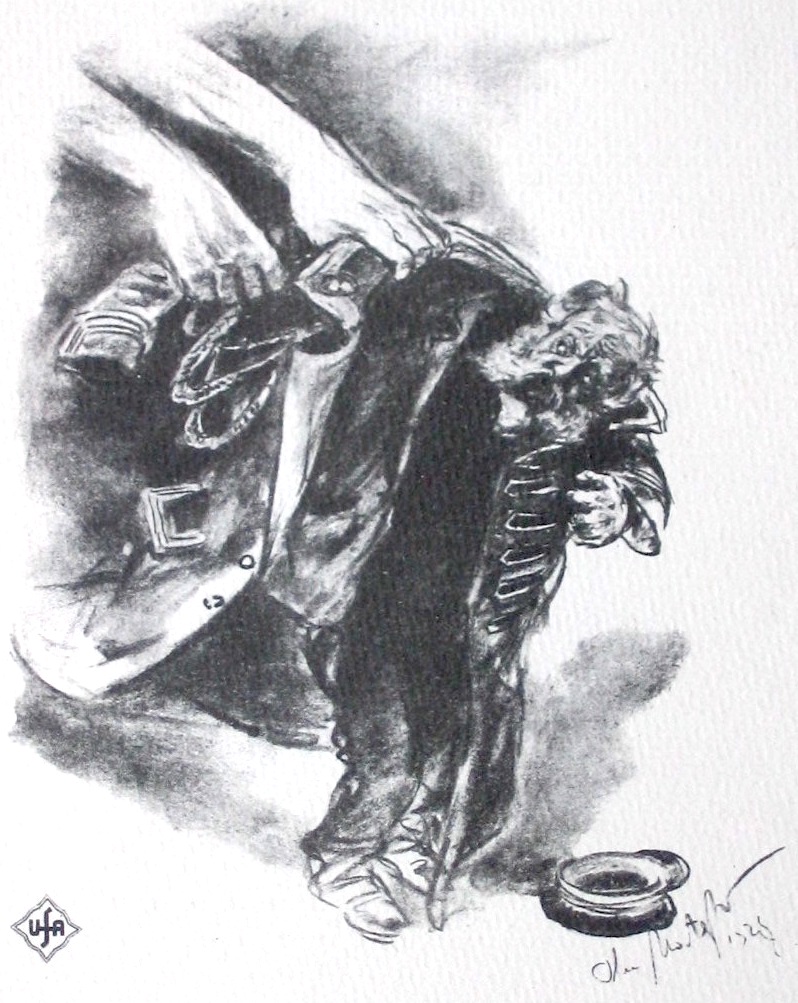Alexander Roob]
[March 15, 2013
Henri Durand-Brager, Special artist of Bonapartism
“The eyes of the world are upon us! … Misfortune has its heroism and its fame.” (Napoleon Bonaparte, St. Helena, Nov. 1815)
“The Napoleonic idea broke forth from St. Helena like the moral doctrine of the Gospel, which had risen, certain of victory, from the agonies of the Calvary.” (Louis-Napoleon Bonaparte, L´Idée Napoléonienne, 1840)
In relevant encyclopaedias of artists, Henri Durand-Brager is predominantly listed as a marine painter, and he was trained as one, yet he was of lasting artistic importance not only in the field of painting but also in the field of reportage drawing. While the works of older artists such as Constantin Guys and Denis Raffet (1) had marked out the basic coordinates of the trade of graphic correspondents, which had begun to slowly emerge with the start of the illustrated press, it was Durand-Brager, who with his entire habitus and flaunted adventurism shaped the role model of the professional pictorial reporter in all its diversity. Younger picture correspondents such as lithographer William Simpson, Melton Prior or Frederic Villiers followed his example. They all latched on to Durand-Brager’s work and thus established the figure of the so-called special artist, who as a chronicler of high capitalism accompanied its numerous internal and external trouble spots.
Anon.: Mr. Durand-Brager, correspondent of L´Illustration in the Crimea, L Illustration, Paris 1856 Vol. I (MePri-coll.)
Emile Bayard after Durand -Brager: L. Simonin and H. Durand-Brager meeting a group of abandoned children, in: L. Simonin : Une excursion dans les quartiers pauvres de Londres, Tour du Monde, Paris 1865
Young Durand-Brager had made a name for himself with an opulent documentation of the return of the remains of the arch-imperator Napoleon I from foreign, British occupied soil to his homeland. It was entirely by chance, and not his intention, that he witnessed this unstopping the bottle of new imperialism, which he then went on to serve as a picture reporter until his death. In early summer of 1840, he departed on a French warship that was meant to uphold the blockade against the Argentine Confederation. During a stop on the African coast, it was surprisingly ordered to St. Helena to support Napoleon’s expedition. So he wasn’t a designated draughtsman of this expedition, as is often claimed, he instead followed the exhumation and return of the military dictator, who had died twenty years earlier, as an uninvited guest. For this reason, he was not allotted a seat in a box during the solemn ceremonies that accompanied this bizarre and ominous act of state.
Durand-Brager’s expedition report Sainte-Hélène. Translation du Cercueil de L’Empereur Napoleon was published in an impressive, large folio format in 1844, the same year as Charles Nodier’s Journal de l’ Expédition des Portes de Fer appeared. (2) In both cases, at issue were highly explosive symbolic acts that served not least to establish the Orleanist dynasty of the Citizen King Louis Philippe. While the Algerian endeavour through the Portes de fer was led by his oldest son, the duc d’Orléans, the youngest son, the prince de Joinville, was the frigate captain of the expedition to St. Helena. As regards the quality of the pictorial layout, no expenses were spared in both cases. While Portes de fer is a milestone in the early history of wood engraving, the Sainte – Hélène cycle of drawings marks a highpoint of early-impressionist landscape lithography in the field of reproduction graphics.
Henri Durand-Brager: Sainte-Hélène. Translation du Cercueil de L’Empereur Napoleon. Paris 1844 (MePri-coll.)
The fact that the chance reportage of marine artist Durand-Brager resulted in the publication of a highly official edition de luxe certainly owed not least to the excellent contacts of his friend and teacher Eugène Isabey. Isabey’s father, Jean-Baptiste, had already served Napoleon I and his Bourbon successors as a highly decorated court painter. Under the aegis of Louis Philippe, he was bestowed the office of curator of the Royal Museums. In the salon of the Isabeys, politicians, fine artists and proponents of new literary realism such as Honoré Balzac and Stendhal encountered each other. The fact that Durand-Brager was able to develop extraordinary literary skills in addition to his drawing abilities may have had to do with this inspiring atmosphere.
Durand-Brager’s mentor, Eugène Isabey, had already departed from classicism and the courtly miniature manner of his father at an early stage in his art. In 1830 he had been present as a military draughtsman when Algiers was conquered. The free, gestural approach which he had developed in his marine and landscape painting following the example of Turner and Constable, brought him in contact with the group of younger plein-air painters surrounding his friend Theodore Rousseau. Among Isabey’s students was his nephew Eugéne Ciceri, who was about the same age as Durand-Brager and just as widely travelled. As an experienced lithographer, Ciceri was also responsible for turning most of the illustrations of Durand-Brager’s Sainte-Hélène cycle into graphic prints. The structural freedom that he displayed in the process already showed the influence of Isabey and the Barbizon School, with which he had been involved since the beginning of the 1840s.(3)
What is remarkable in Durand-Brager’s publication, is that it completely disregards the actual subject-matter, the emperor’s coffin and the pivotal act of transporting it back. In the series of historical paintings in which Eugéne Isabey, Antoine-Léon Morel-Fatio and Henri-Félix-Emmanuel Philippoteaux rendered the arrival of the expedition in France, this coffin quite naturally forms the magnetic centre. This is also the case in the lithographic accordion-fold in which the befriended illustrator Charles Nicolas Lemercier recorded the solemn procession of the corpse from the Champs-Élysées to the new grave at Les Invalides.
Henri Durand-Brager: Sainte-Hélène. Translation du Cercueil de L’Empereur Napoleon. Paris 1844 (MePri-coll.)
Eugène Isabey: Le transfert des cendres de Napoléon à bord de La Belle Poule, le 15 octobre 1840. Huile sur Toile. 1843 (Musée national du Château de Versailles)
Charles Nicolas Lemercier: Translation du corps de Napoleon. Napoleon de la vallée du tombeau au dome des Invalides; suivi du panorama du trajet parcouru par le cercueil. Paris. n.d. (ca. 1842) (MePri-coll.)
Each phase of the spectacular return of the deceased, who had already been considered a celestial manifestation during his lifetime, was meticulously captured by Louis Philippe’s court artists. Durand-Brager had indeed addressed the exhumation and transport in all details in his vivid and graphic introduction, but in the picture section of Sainte Hélène consisting of twenty-five lithographic pages he plays about these actions and dissolves them in a sequence of topographic depictions showing the arrival and departure of the ships as well as the route from the port to the former homestead of Napoleon and to his grave.
With this iconic exclusion, the artist succeeded in catering to two opposite intentions. On the one hand, this absence – in the light of the ruling and censoring July Monarchy – could be judged as an attempt to neutralize or profane the ominous Napoleon cult. On the other hand, with this restraint he also accommodated the popular adoration of the dead emperor in a highly effective and respectful way. As a result, the representation of the landscape carried much more weight. The depiction of the insular solitude simultaneously referred in a concrete manner to Napoleon’s time of suffering on St. Helena, which was characterized by harassing and paranoid British surveillance and inhospitable climatic conditions. In the diaries of Count Las Cases, who had followed Napoleon to St. Helena, the banishment of the emperor was described in great detail and staged as a pseudo-religious martyrdom. Las Cases’ conversations with the exiled emperor had been published under the title Mémorial de Sainte Hélène as a five-volume edition in 1823. It ranked among the most popular publications of its times. The basics of Napoleonic foreign, domestic and social policies were also elaborated at great length. Here, the failed autocrat had the opportunity to present himself in the aureole of a “Messiah of the freedom of the people” , as the hereditary custodian of the French Revolution and advocate of liberalism. One can assume that almost everyone who took a look at Durand-Brager’s Sainte Hélène folios had studied Las Cases´ Memorial. (4)
Las Cases´ Memorial also forms the foundation on which the nephew of the deceased emperor and his self-proclaimed political heir, Louis-Napoléon, had built his popular manifesto from 1840, L’ idée napoléonienne. The political gambler, who like the entire Bonaparte clan was imposed with a ban on residence in his homeland, had tried to underpin his dynastic claim to power with this publication and a first attempted coup in Strasbourg in 1836. He had headed his manifesto with a motto alluding to the long smouldering debate on the return of his uncle’s corpse: “It is not only about returning the mortal remains of the emperor but his ideas.”
From the very onset, the July Monarchy had been confronted by demands to bring the national idol back home. Once it had given in to the increasing pressure after ten years, the posthumous Napoleon nostalgia had reached its boiling point. Louis-Napoléon tried to seize the opportunity and attempted a second coup from England concurrently with the St. Helena expedition, after having secured the support of the French Africa army. But this adventurous attempted coup also failed due to the amateurish way in which it was conducted. Yet the timing was perfect, for at the same time as the body of old Napoleon arrived in Paris, his nephew and revenant was able to adorn himself with the stigmata of a life sentence.
Anon.: Bonapartistische Verwandtschaftsverhältnisse / Bonapartistic relationships, Journal pour rire, Vol. I, Paris 1848 (MePri-coll.)
In 1844, when Sainte Hélène was published, the Bonapartist threat appeared to have been averted. Without this imagined certainty, the publication of Durand-Brager’s lithographic cycle would hardly have been conceivable, because he aggressively played into the hands of Louis-Napoléon’s postulate after the return of the Bonapartist idea precisely for the reason that he had disregarded the aspect of his physical transport back home. It was this Bonapartist spirit of imperialism that the expedition from British exile in St. Helena to France had exported that could celebrate its final revival with the flight of the nephew from imprisonment in 1846 and his proclamation as emperor in 1852.
In the Second Empire, the spark of this Bonapartist return also ignited the artist Durand-Brager. He had meanwhile established himself as a chronicler of French colonial wars through his picture reportages of the Morocco campaign. With his style and characteristic handlebar moustache, Durand-Brager acted like the doublet of the new emperor, who now called himself Napoleon III. Durand-Brager accompanied his twenty-one-year reign as a pictorial court reporter, drawing him at his jubilation events and extensive tours through the French province and the Algerian colony and documenting his prestigious wars as a special artist and pioneer of war photography in the Crimea and Sardinia.
L Illustration, Paris 1854 Vol. II (MePri-coll.)
L Illustration, Paris 1855 Vol. I (MePri-coll.)
L Illustration, Paris 1855 Vol. I (MePri-coll.)
L Illustration, Paris 1854 Vol. I (MePri-coll.)
L Illustration, Paris 1854 Vol. II (MePri-coll.)
Henri Durand Brager pinx. / Lemercier imprim.: Vue de Kamiesch, (Lithography) Paris 1855 (MePri-coll.)
Henri Durand Brager: Voyage de l´empereur: Arrivée a Alger Le Monde Illustré, 1865 Vol. I
However, his reportages in words and images distinguish themselves pleasantly in regard to the precision of the descriptions and the objective and unpretentious style from the cocky gestures of most of his colleagues, who were more interested in dramatic effects. His report on the Sicilian guerrilla war under Garibaldi, which appeared in 1861 in French and also in a German translation, (5) counts as one of the best literary reportages of its times due to the succinct and atmospherically dense description of landscapes, battles and civilian casualties.
Henri Durand Brager: L´expedition de Garibaldi Le Monde Illustré, 1860 Vol. II
Henri Durand Brager: The Fall of Palermo, Le Monde Illustré, 1860 Vol. II
Just a few years later, Durand-Brager, in collaboration with Louis Laurent Simonin, a pioneer of industrial reportage, provided descriptions of two nightly rides in England’s “workshop of the world” for the illustrated travel magazine Le Tour du Monde; one report on the social conditions in the polluted mining regions of Wales, followed by an underworld report from the slums of London. The latter is a milestone of social-investigative pictorial reportage. Several years later, Durand-Brager’s drawings for Une Excursion Dans Les Quartiers Pauvres De Londres served as a blueprint for the most popular and seminal graphic depiction of pauperism, Gustave Doré’s and Douglas Jerrold’s London. A Pilgrimage.(6)
Louis Laurent Simonin / Henri Durand-Brager: Un voyage aux mines du cornouailles, Tour du Monde, Paris 1865
Louis Laurent Simonin / Henri Durand-Brager: Une excursion dans les quartiers pauvres de Londres ,Tour du Monde, Paris 1865
Yet with these social-investigative endeavours, the reporter of the new Napoleon had departed from the Bonapartist doctrines to a far lesser extent than one would presume. During his confinement in a fortress, Louis-Napoléon had reflected on updating the main features of Bonapartist social policies in times of advanced industrialisation. The same year that Durand-Brager’s Sainte Hélène testimony appeared, a treatise of the nephew titled L´Extinction du Pauperisme circulated. In his proposals to solve the problem of pauperism, Louis-Napoléon, with his intimate knowledge of the English conditions, had come surprisingly close to early-socialist conceptions such as the co-operative movement of Robert Owen and the Chartist agrarian reform initiative of Feargus O´Connor. When he finally came to power, however, little more was left of these egalitarian ideas than the paternalistic gesture of an autocrat justified by a plebiscite.
Alexander Roob, August 2011
Anmerkungen:
1) > Alexander Roob: Auguste Raffet & Horace Vernet – Pictures of Dynamized Masses and the Art of Reconstruction. Mepri- Archive 09 / 11
2) > Alexander Roob: Die eisernen Pforten der Unterwerfung. Mepri-Archive
3) Eugene Ciceri etablierte sich in der Folgezeit parallel zu seinen impressionistischen Landschaftsmalereien als einer der führenden Reproduktionsgrafiker der Zeit.
4) Dessen Autor selbst gehörte zusammen mit seinem Sohn zu den prominentesten Teilnehmern der Rückführungsexpedition. Porträtstiche der beiden Las Cases finden sich auch im Eingang zu Durand Bragers Bildband reproduziert, der, wie auch aus dem Untertitel hervorgeht, als ein luxuriöses Supplement zu diesem napoleonischen Evangelium konzipiert war: „Histoire et vues pittoresques de tous les sites de l’île se rattachant au Mémorial de Sainte-Hélène“
5) Henri Durand Brager: Quatre Mois de L’Expedition de Garibaldi en Sicilie et Italie / Erinnerungen eines Rothhemdes. Vier Monate Feldzug unter Garibaldi in Sizilien und Neapel.
6) > Alexander Roob: Terra Incognita II, Gustave Doré und die Tradition der London – Reportage. 2010 (bislang unveröffentlicht)
Durand Brager and Bonapartism. (In the Collections)
Comte Emmanuel Augustin de Las Cases: Denkwürdigkeiten von Sanct-Helena, oder Tagebuch, in welchem alles, was Napoleon in einem Zeitraume von achtzehn Monaten gesprochen und gethan hat, Tag für Tag aufgezeichnet ist. Stuttgart / Tübingen 1823-1826
Auguste Barthélemy et Joseph Méry: Napoleon en Egypte, Waterloo et le Fils de l´Homme, Paris 1842
Charles Nicolas Lemercier: Translation du corps de Napoleon. Napoleon de la vallée du tombeau au dome des Invalides; suivi du panorama du trajet parcouru par le cercueil. Paris. n.d. (ca. 1842)
Henri Durand Brager: Sainte-Hélène. Translation du Cercueil de L’Empereur Napoleon. Histoire et vues pittoresques de tous les sites de l’île se rattachant au “Mémorial de Sainte-Hélène” et à l’expédition de S.A.R. le Prince de Joinville. Paris 1844
Louis Napoleon Bonaparte: The Political And Historical Works Of Louis Napoleon Bonaparte, President Of The French Republic. With an Original Memoir of his Life Brought Down to the Promulgation of the Constitution of 1852, London 1852
Henri Durand Brager pinx. / Lemercier imprim.: Vue de Kamiesch, (Lithography) Paris 1855
Henri Durand Brager: Erinnerungen eines Rothhemdes. Vier Monate Feldzug unter Garibaldi in Sizilien und Neapel. Gotha 1861
Paul Hadol: La Menagerie Imperiale.Composée Ruminants, Amphibi, Carnivores, et autres budgetivores qui ont devorce la France pendant 20 ans. Paris 1870
Thomas Nast: Napoleon III in Fontainbleau ( Sketch, Pen on Paper, 18 x 22,5 cm) 1870
Arthur Mangin: Voyages et découvertes outre-mer au XIX° siècle. Paris 1883
Friedrich Schulze: Die deutsche Napoleon – Karikatur. Weimar 1916
Paul Hogarth: The Artist as Reporter. London 1967
Sabine und Ernst Scheffler, Gerd Unverfehrt: So zerstieben geträumte Weltreiche. Napoleon I. in der deutschen Karikatur. Stuttgart 1995
Ulrich Keller: The Ultimate Spectacle: A Visual History of the Crimean War. London 2001
Bénédicte Savoy ed.: Napoleon und Europa. Traum und Trauma. München 2010
Durand Brager in Illustrated Magazines:
L Illustration, Paris 1854 Vol. II / 1855 Vol. I + II
Magasin Pittoresque, Paris 1856
Le Monde Illustré, 1860 Vol. II / 1863 I + II / 1865 I + II / 1866 I + II / 1868 Vol II
Tour du Monde, Paris 1865
Le Journal Illustre, Paris 1866
De Aarde en Haar Volken. Haarlem 1868
